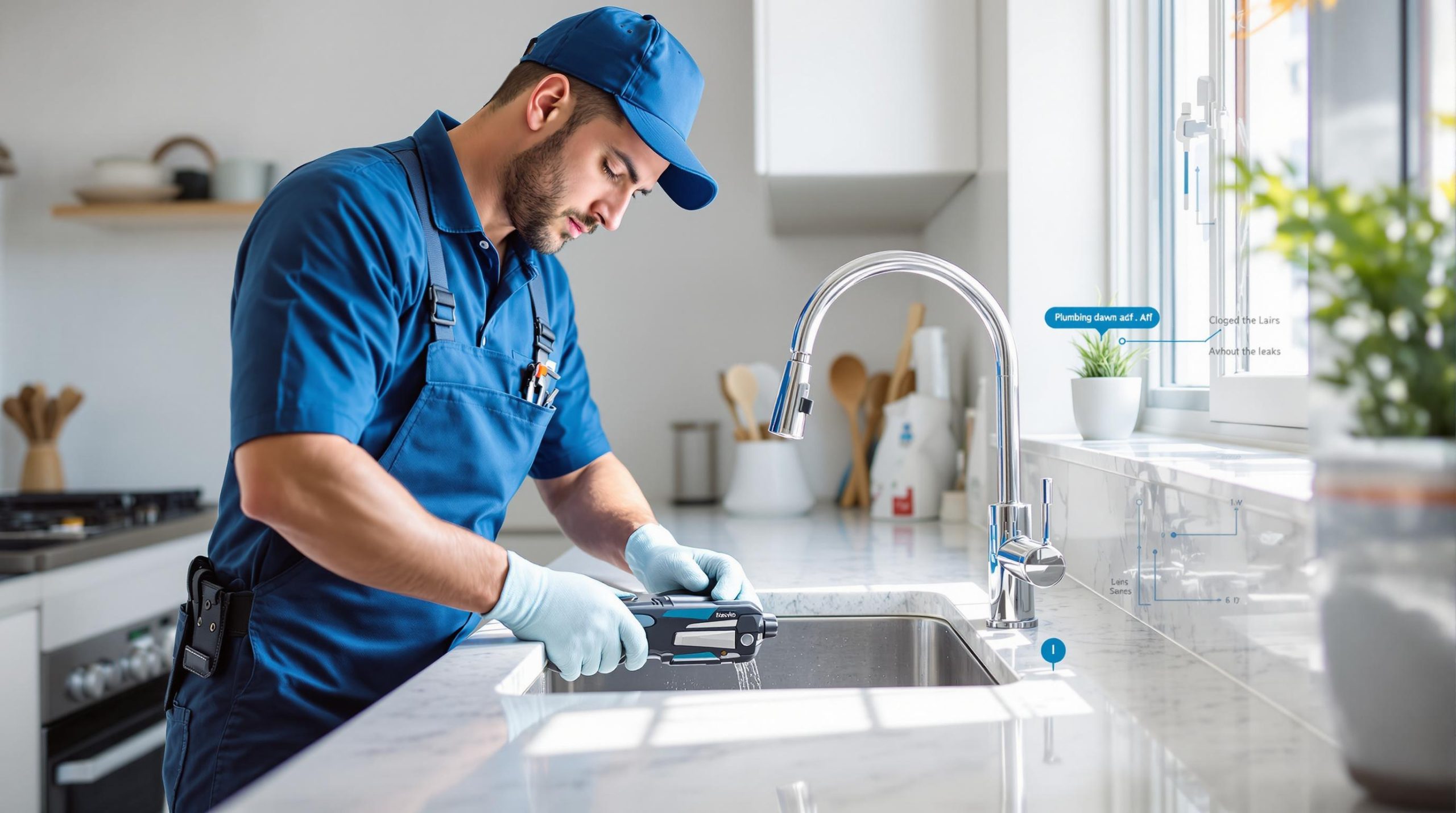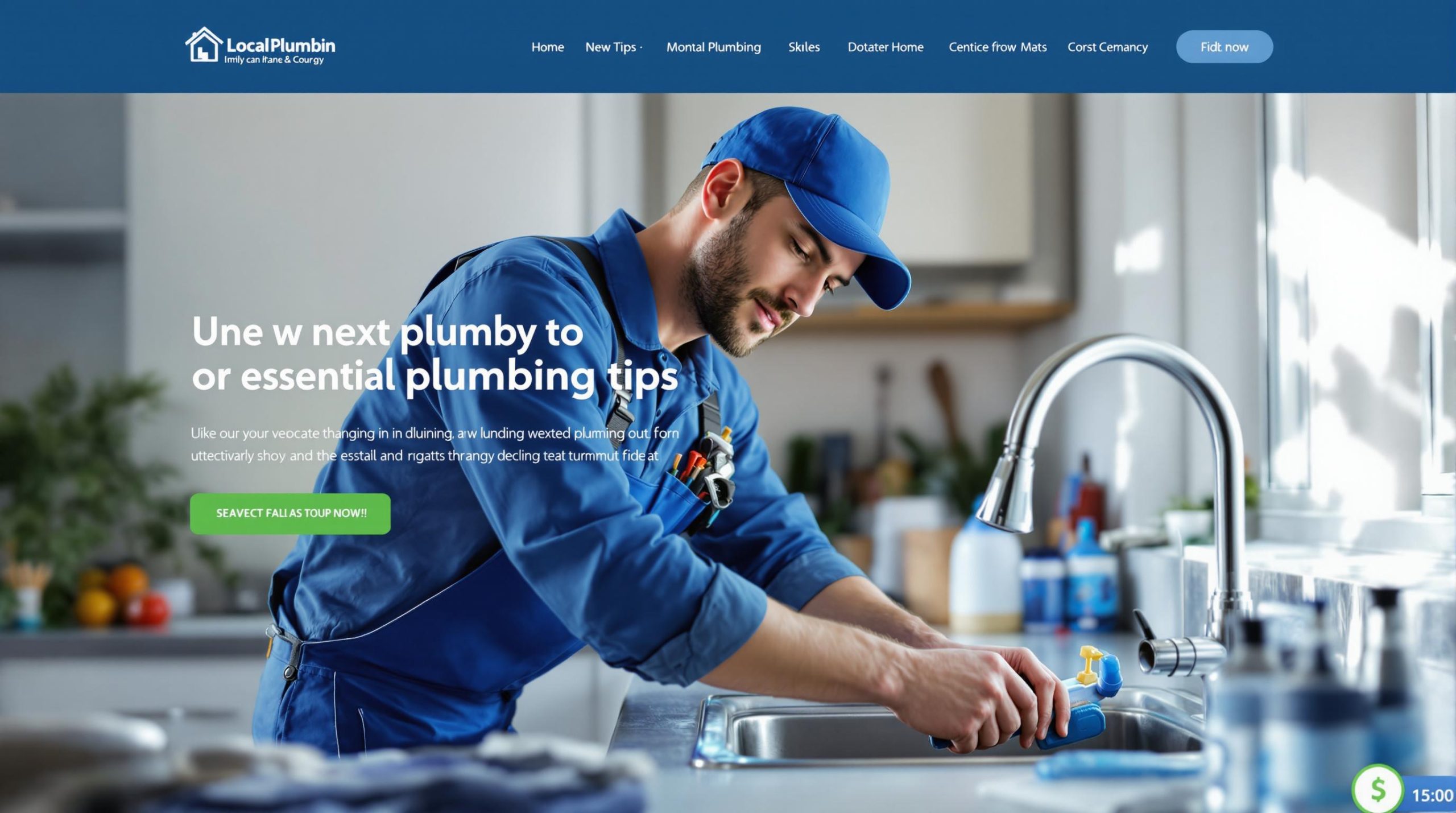Plumbing issues can disrupt your daily life and lead to costly repairs if not addressed promptly. Here’s a quick guide to the most common problems and how to fix them:
- Clogged Drains: Caused by hair, soap scum, grease, or tree roots. Signs include slow drainage and foul odors.
- Low Water Pressure: Often due to sediment buildup, leaks, or clogged filters.
- Leaky Pipes and Faucets: Look for water stains, high water bills, or musty odors.
- Sewer Line Clogs: Multiple drain backups or sewage smells indicate trouble.
- Water Heater Issues: Fluctuating temperatures and strange noises signal potential problems.
Quick Solutions:
- Use a plunger or drain snake for clogs.
- Clean showerheads and filters to restore water pressure.
- Patch small leaks temporarily or replace faucet washers.
- Flush your water heater annually to prevent sediment buildup.
Preventive Maintenance Tips:
- Clean drains monthly.
- Inspect for leaks regularly.
- Test water pressure often.
- Avoid disposing of grease or non-flushable items down drains.
For major issues like sewer line clogs or water heater failures, call a licensed plumber. Regular maintenance can save money and keep your plumbing system running smoothly.
5 Major Plumbing Problems: Causes and Signs
Clogged Drains
Clogged drains are one of the most frequent plumbing problems. Lucas Cook from Optimised Plumbing Services explains, "Having a blocked drain is an extremely common plumbing problem and is one of the main requests that plumbers are often called out to resolve".
Here’s a breakdown of common culprits and their warning signs:
| Material | Location | Warning Signs |
|---|---|---|
| Hair & Soap Scum | Bathroom drains | Slow drainage, gurgling sounds |
| Grease & Food | Kitchen sink | Water backing up, foul odors |
| Tree Roots | Main sewer lines | Multiple drain backups, yard puddles |
| Hygiene Products | Toilet lines | Frequent clogs, overflow issues |
Water Pressure Problems
Low water pressure can make daily activities frustrating. Signs to look for include weak flow from multiple fixtures and inconsistent pressure throughout your home. Common causes include:
- Sediment buildup in pipes and fixtures
- Hidden leaks in the plumbing system
- Clogged filters or aerators
- Aging or malfunctioning water heaters
Addressing these issues early can prevent more extensive damage and costly repairs.
Pipe and Faucet Leaks
Leaking pipes and faucets not only waste water but can also cause serious structural damage. Keep an eye out for these signs:
- Water stains on walls or ceilings
- Unexpectedly high water bills
- Musty odors in bathrooms or kitchens
- Warped or discolored flooring
- Dripping sounds when fixtures aren’t in use
Main Sewer Line Clogs
A clogged sewer line can lead to hazardous conditions for your home and health. Be alert for these red flags:
- Multiple drains backing up at once
- Sewage odors coming from drains
- Gurgling toilets when using sinks
- Wet or soggy spots in your yard
- Slow drainage throughout the house
Hot Water System Problems
Issues with your hot water system can disrupt your routine and might signal larger problems. Look for these warning signs:
- Fluctuating water temperatures
- Strange noises from the water heater
- Rusty or discolored hot water
- Reduced hot water pressure
- Longer heating times than usual
Identifying these problems early can help you choose the best repair approach, keeping your plumbing system in good shape.
Most Common Plumbing Problems in Homes | How to Identify …
How to Fix Common Plumbing Issues
Here are practical solutions for some of the most common plumbing problems.
Drain Clearing Methods
Blocked drains? Try these approaches:
| Method | Best For | Cost Range | Effectiveness |
|---|---|---|---|
| Plunger | Surface clogs, toilets, sinks | $5-$20 | High for simple clogs |
| Drain Snake | Hair clogs, shower drains | $10-$50 | Medium to high |
| Auger | Deep blockages | $50-$500 | Very high |
| Chemical Cleaners | Grease, soap scum | $5-$20 | Variable |
"Not many people know about ‘Zip it’ drain cleaners but they are a good DIY cleaning tool when you have hair stuck down a drain. You can find them on Amazon or in some hardware stores, they are cheap and can be worth a try." – Dylan Attard, Licensed Plumber at True Flow Plumbing and Drains
For better plunger results, seal any secondary drain openings to improve suction. You can also try a mix of baking soda and vinegar. Let it sit for 15-20 minutes, then flush with hot water.
If your issue isn’t a clog, low water pressure might be the problem.
Fixing Low Water Pressure
To pinpoint the cause, compare the pressure of hot and cold water. If hot water pressure is the issue, focus on your hot water system. Here are common fixes:
- Clean or Replace Showerheads: Soak the showerhead in vinegar for 4–6 hours to dissolve mineral buildup. If cleaning doesn’t work, replace it.
- Check Water System Filters: Look for sediment buildup on both the inlet and outlet filters of your hot water system, and clean them thoroughly.
- Monitor for Leaks: Turn off all fixtures and watch your water meter. Any movement could indicate a hidden leak.
Once the pressure is back to normal, you can move on to tackling leaks.
Leak Repair Steps
Small leaks need quick attention. Temporarily patch pipe leaks with wrap or epoxy putty until you can call a professional. For faucet leaks, replacing the washer or O-ring often does the trick.
Sewer Line Repair Options
Use a camera inspection to locate the exact issue in your sewer line. For tough blockages, hydro-jetting is a reliable option.
Water Heater Care
Keep your water heater in good shape by flushing it annually to remove sediment. Regularly check the pressure relief valve and inspect for any signs of leaks or corrosion.
Key maintenance tips:
- Set the temperature between 120-140°F (49-60°C).
- Ensure proper ventilation around the unit.
- Address unusual noises or temperature inconsistencies right away.
While you can handle minor leaks and clogs yourself, major repairs – like those involving hot water systems or sewer lines – are best left to professionals.
sbb-itb-c287090
Preventing Plumbing Problems
Regular upkeep is key to avoiding emergencies and expensive repairs. Beyond the repair methods mentioned earlier, consistent maintenance helps extend the lifespan of your plumbing system.
Monthly Maintenance Checklist
Use this monthly checklist to address potential problems before they escalate:
| Task | Frequency | Why It’s Important |
|---|---|---|
| Drain Cleaning | Monthly | Stops debris buildup and prevents clogs |
| Leak Inspection | Monthly | Detects potential water damage early |
| Toilet Component Check | Monthly | Ensures proper flushing functionality |
| Water Pressure Test | Monthly | Keeps the system running efficiently |
After completing these tasks, make sure to check your water pressure for overall system efficiency.
Water Pressure Checks
Proper water pressure is crucial for keeping your plumbing system in good condition. The recommended pressure range is between 40–85 PSI. Here’s how to check it:
- Get a pressure gauge – You can find one at most hardware stores for about $10–15.
- Test during peak times – Check the pressure during high-demand hours, like mornings or evenings.
- Test multiple locations – Check both indoor and outdoor faucets.
If you notice a gradual drop in pressure, inspect your pressure regulator and replace it if necessary. Hard water can also cause mineral buildup, narrowing pipes and reducing pressure over time.
Safe Drain Use Guidelines
Proper waste disposal is another way to protect your drains and avoid blockages. Follow these simple tips:
| Avoid Disposing | Use This Instead |
|---|---|
| Fats, Oils & Grease | Let them cool and toss in trash |
| Non-flushable Items (e.g., wipes) | Throw them in the garbage |
Additionally, consider installing drain screens in sinks and showers to catch hair and debris. This small step can save you from bigger problems down the line.
Plumbing Tools and Methods
Basic Home Plumbing Tools
Having the right tools at home can help you tackle minor plumbing problems without needing to call a professional.
| Tool | Purpose |
|---|---|
| Cup Plunger | Clears sink and drain clogs |
| Flange Plunger | Clears toilet clogs |
| Plumbing Snake | Removes deep drain blockages |
| Pipe Wrench | Grips and turns pipes |
| Plumbers Tape | Seals threaded connections |
| Cartridge Gun | Applies sealant |
| Needle-nose Pliers | Handles small components |
| Plumbers Putty | Creates water-resistant seals |
For more complex issues, basic tools may not be enough, and advanced methods or equipment might be required.
Advanced Repair Methods
When plumbing problems go beyond simple fixes, advanced tools and techniques come into play. For instance, motorized augers are commonly used to handle severe blockages. These professional-grade tools, which range in price from $50 to $500 or more, are highly effective but require careful handling.
"Motorized augers are best left to professionals. If using a manual auger, feed it carefully and rotate to break up the clog." – Dylan Attard, licensed plumber at True Flow Plumbing and Drains
Another key tool for professionals is a camera system, which helps inspect the inside of pipes and pinpoint issues accurately. For cutting pipes, options include pipe cutters for clean cuts, hacksaws for versatility, and metal files to smooth rough edges.
Keep in mind that some plumbing tasks may require permits or professional certification depending on your state’s regulations.
Using the right tools – whether basic or advanced – can help keep your plumbing system in good shape for the long haul.
Conclusion
Keeping your plumbing system in good shape requires consistent DIY care and timely professional help. While basic tools and know-how can handle minor issues, bigger problems should be left to licensed experts. Regular checks and quick action on small issues can save you from costly repairs later.
Here’s a simple maintenance schedule to guide you:
| Task Frequency | Recommended Actions | When to Call a Professional |
|---|---|---|
| Monthly | Look for leaks, test water pressure, clean drain covers | If low pressure persists or clogs keep coming back |
| Quarterly | Check visible pipes, test shut-off valves, flush the water heater | If you notice pipe corrosion or valve issues |
| Annually | Schedule a full system inspection and water heater service | For system-wide problems or major installations |
By sticking to this schedule, you can avoid major plumbing problems. Whether you’re a homeowner or running a commercial property, regular maintenance not only keeps your system running smoothly but also helps save on water bills and repair costs.
For emergencies like burst pipes or serious leaks, don’t hesitate – call a licensed professional right away for safe and reliable repairs.



